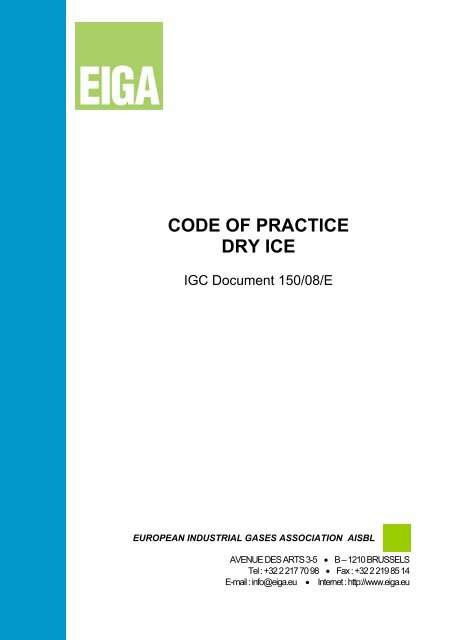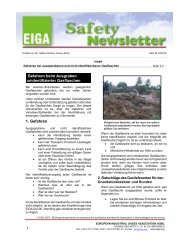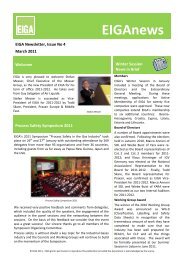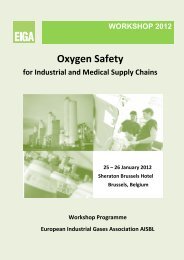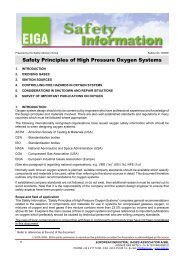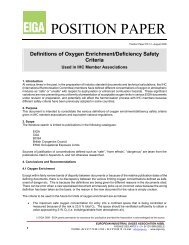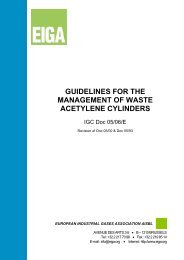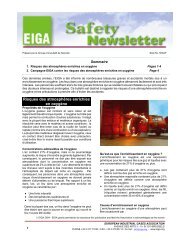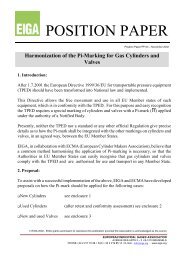CODE OF PRACTICE DRY ICE - eiga
CODE OF PRACTICE DRY ICE - eiga
CODE OF PRACTICE DRY ICE - eiga
Create successful ePaper yourself
Turn your PDF publications into a flip-book with our unique Google optimized e-Paper software.
<strong>CODE</strong> <strong>OF</strong> <strong>PRACT<strong>ICE</strong></strong><br />
<strong>DRY</strong> <strong>ICE</strong><br />
IGC Document 150/08/E<br />
EUROPEAN INDUSTRIAL GASES ASSOCIATION AISBL<br />
AVENUE DES ARTS 3-5 • B – 1210 BRUSSELS<br />
Tel : +32 2 217 70 98 • Fax : +32 2 219 85 14<br />
E-mail : info@<strong>eiga</strong>.eu • Internet : http://www.<strong>eiga</strong>.eu
Doc 150/08<br />
<strong>CODE</strong> <strong>OF</strong> <strong>PRACT<strong>ICE</strong></strong><br />
<strong>DRY</strong> <strong>ICE</strong><br />
PREPARED BY :<br />
De Lorenzi Lorenzo SOL<br />
Goossens Rudy MESSER<br />
Jaeger Jens LINDE GAS<br />
Pieper Sönke LINDE GAS<br />
Puype Herman EIGA<br />
Speelmans Stefan ACP<br />
Trundley Colin YARA<br />
Disclaimer<br />
All technical publications of EIGA or under EIGA's name, including Codes of practice, Safety procedures and any other technical<br />
information contained in such publications were obtained from sources believed to be reliable and are based on technical<br />
information and experience currently available from members of EIGA and others at the date of their issuance.<br />
While EIGA recommends reference to or use of its publications by its members, such reference to or use of EIGA's publications by<br />
its members or third parties are purely voluntary and not binding.<br />
Therefore, EIGA or its members make no guarantee of the results and assume no liability or responsibility in connection with the<br />
reference to or use of information or suggestions contained in EIGA's publications.<br />
EIGA has no control whatsoever as regards, performance or non performance, misinterpretation, proper or improper use of any<br />
information or suggestions contained in EIGA's publications by any person or entity (including EIGA members) and EIGA expressly<br />
disclaims any liability in connection thereto.<br />
EIGA's publications are subject to periodic review and users are cautioned to obtain the latest edition.<br />
© EIGA 2008 - EIGA grants permission to reproduce this publication provided the Association is acknowledged as the source<br />
EUROPEAN INDUSTRIAL GASES ASSOCIATION AISBL<br />
Avenue des Arts 3-5 B 1210 Brussels Tel +32 2 217 70 98 Fax +32 2 219 85 14<br />
E-mail: info@<strong>eiga</strong>.eu Internet: http://www.<strong>eiga</strong>.eu
IGC DOC 150/08<br />
Table of Contents<br />
1 Introduction ......................................................................................................................................1<br />
2 Scope...............................................................................................................................................1<br />
3 Definitions ........................................................................................................................................1<br />
Dry ice - food application .................................................................................................................2<br />
4 Dry Ice Production ...........................................................................................................................2<br />
5 Properties and Hazards ...................................................................................................................2<br />
5.1 Properties .................................................................................................................................2<br />
5.2 Hazards ....................................................................................................................................4<br />
6 Specific requirements for dry ice for food applications ....................................................................4<br />
6.1 Raw materials ...........................................................................................................................5<br />
6.2 Product quality..........................................................................................................................5<br />
6.3 Quality management system ....................................................................................................5<br />
6.4 HACCP .....................................................................................................................................5<br />
6.5 Traceability & management of non-conforming product...........................................................5<br />
7 Requirements for dry ice premises ..................................................................................................5<br />
8 Production equipment requirements................................................................................................6<br />
8.1 Storage vessels for liquid CO2..................................................................................................6<br />
8.2 Recovery plant..........................................................................................................................6<br />
8.3 Production, handling and packaging equipment ......................................................................6<br />
8.4 Cleaning regimes......................................................................................................................7<br />
9 Containers........................................................................................................................................7<br />
10 Wrapping and packaging .............................................................................................................8<br />
11 Transport ......................................................................................................................................8<br />
12 Personnel requirements and safety .............................................................................................9<br />
13 Safety information ......................................................................................................................10<br />
14 Training of personnel..................................................................................................................10<br />
Appendix I: Relevant European Legislation..........................................................................................11<br />
Appendix II: Relevant EIGA Documents ...............................................................................................12<br />
Appendix III: Safety Information............................................................................................................13<br />
Appendix IV: Safety Data Sheet ...........................................................................................................14
IGC DOC 150/08<br />
1 Introduction<br />
Dry ice is CO2 in its solid form, produced by expanding liquid CO2 to atmospheric pressure.<br />
The product can be supplied as either blocks, slices or pellets and is generally packed into plastic,<br />
paper or composite bags that are stored and transported in insulated containers. Some products<br />
(particularly pellets) can also be supplied "loose" in containers, with no wrapping.<br />
Dry ice is used in practically all types of industries, mainly because of its cooling properties. It is<br />
particularly interesting for applications where "spot cooling" is needed.<br />
The most common uses are:<br />
• Cooling<br />
o Cooling of catering trolleys in airplanes, trains ..<br />
o Cooling of food, pharmaceutical products, etc. during transport without direct contact<br />
between product and dry ice (to maintain the “cold chain”)<br />
o Cooling of food with direct contact between dry ice and the product (meat, grapes,…)<br />
o Direct application in food mixing processes in order to maintain the temperature<br />
o Cooling metal<br />
• Blast cleaning with dry ice<br />
• Bacteriostatic use<br />
o Modified atmosphere packaging in food to produce a protective, bacteriostatic<br />
atmosphere.(gasphase)<br />
When dry ice is added directly to food, it is important to consider its possible role as a carrier of<br />
contamination. The quality of the raw material (liquid CO2) shall conform to the purity criteria for food<br />
additive (E290).<br />
2 Scope<br />
This guide covers the entire supply chain of all dry ice products, from the receipt of bulk liquid carbon<br />
dioxide to the delivery of finished products to end-users.<br />
The document provides specific guidelines for safe and hygienic handling of product, equipment and<br />
containers throughout the production and supply chain.<br />
In the gases industry, dry ice is the only solid product and, unlike other food gas products, is not kept<br />
in a closed pressurised system. It therefore requires that specific attention be paid to food hygiene.<br />
3 Definitions<br />
“Cold chain”<br />
Temperature control system for food transport.<br />
1
IGC DOC 150/08<br />
Control measure<br />
Action or activity that can be used to prevent or eliminate a hazard.<br />
Dry ice<br />
Solid carbon dioxide.<br />
Dry ice - food application<br />
Application in which dry ice is in direct contact with food during the manufacturing process. An<br />
example would be the direct use of dry ice as a cooling agent in a meat grinding or mixing application.<br />
Dry ice – non food application<br />
Application in which dry ice does not come into direct contact with food. An example would be the use<br />
of packaged dry ice as a refrigerant for indirect cooling of food in insulated transport containers.<br />
HACCP<br />
“Hazard Analysis of Critical Control Points”. Standard risk assessment process widely used in the<br />
food industry.<br />
4 Dry Ice Production<br />
Liquid CO2 is supplied from road tankers, rail tankers, or directly from the CO2-production plant into<br />
the storage tanks.<br />
The usual working pressure is 15 bar g.<br />
The liquid CO2 is injected into appropriate presses with snow towers or chambers and expanded to<br />
approx. 1 bar g. Approximately 50 % CO2-snow and 50 % cold CO2-gas (-78,5°C) is generated.<br />
The CO2-snow is pressed hydraulically into blocks, pellets, or slices. Slices of special sizes are<br />
produced by sawing up blocks. Despatch, packed or unpacked, is done in special insulated<br />
containers.<br />
In smaller dry ice plants production often is done without recovery of the CO2-gas. For larger<br />
production plants where recovery is required, the cold gas is compressed by means of compressors,<br />
condensed in the CO2-liquefier, and then recycled into the dry ice process. The necessary<br />
refrigeration is by a closed loop refrigeration system using a refrigerant gas.<br />
5 Properties and Hazards<br />
5.1 Properties<br />
Gaseous state<br />
At normal temperature (+15°C) and atmospheric pressure CO2 has a density of 1,87 kg/m3 and is 1,5<br />
times heavier than air. It is a colourless and odourless gas (with a slightly pungent odour at higher<br />
concentrations) and spreads along the ground, collecting in low-lying areas such as pits and cellars.<br />
2
IGC DOC 150/08<br />
Carbon Dioxide is classified as a non toxic gas but it does start to affect breathing at a concentration<br />
of approximately 1 % with effects becoming more serious with increasing concentrations.<br />
Carbon Dioxide is non-flammable.<br />
Liquid state<br />
CO2 can exist as liquid below the critical temperature of 31°C and above the triple point with a<br />
temperature of -56,6°C and 4,18 bar gauge (barg). CO2 is transported, stored and handled in liquid<br />
form, either at ambient temperature (in cylinders or uninsulated storage tanks at a pressure of 45 - 65<br />
barg) or refrigerated (in insulated tankers and storage tanks) at a temperature range of -35 to -15°C<br />
and a pressure range of 12 to 25 barg. The CO2 in this state is liquid at its boiling point.<br />
Below the triple point 4,18 barg and -56,6°C CO2 can only exist in the solid and the gas phase.<br />
Therefore liquid CO2 cannot exist at atmospheric pressure. When the liquid CO2 is depressurised<br />
below the triple point pressure of 4,18 barg to atmospheric pressure it is transformed to dry ice and<br />
gas, consequently when the liquid CO2 is released to the atmosphere a dense white fog of powdery<br />
solid carbon dioxide particles and vapour is produced.<br />
Solid state (Dry ice)<br />
The expansion of liquid CO2 to atmospheric pressure is used to produce CO2 snow at a temperature<br />
of -78,5°C. The snow is compressed to form dry ice blocks, slices or pellets.<br />
3
IGC DOC 150/08<br />
5.2 Hazards<br />
Asphyxiation<br />
Carbon Dioxide is classified as a non-flammable, non-toxic liquefied gas. It is normally present in<br />
atmospheric air at a level of approximately 380 parts per million (0,038 %). It is a normal product of<br />
metabolism being held in bodily fluids and tissues where it forms part of the bodies normal chemical<br />
environment. In the body it acts in the linking of respiration, circulation and vascular response to the<br />
demands of metabolism both at rest and in exercise.<br />
The effects of inhaling low concentrations of carbon dioxide are physiological reversible but in high<br />
concentrations the effects are toxic and damaging.<br />
Note: The effects of carbon dioxide are entirely independent of the effects of oxygen deficiency.<br />
The oxygen content in the atmosphere is therefore not an effective indication of the danger. It is<br />
possible to have an acceptable low oxygen content of 18% and a high carbon dioxide content, 14 %<br />
being very dangerous.<br />
Individual tolerances can vary widely, dependent on the physical condition of the person and the<br />
temperature and humidity of the atmosphere, but as a general guide, the effects of inhaling varying<br />
concentrations of carbon dioxide are likely to be as follows:<br />
Concentrations by volume - likely effects:<br />
1-1.5% Slight effect on chemical metabolism after exposure of several hours.<br />
3% The gas is weakly narcotic at this level, giving rise to deeper breathing, reduced hearing<br />
ability, coupled with headache, an increase in blood pressure and pulse rate.<br />
4-5% Stimulation of the respiratory centre occurs resulting in deeper and more rapid breathing.<br />
Signs of intoxication will become evident after 30 minutes exposure.<br />
5-10% Breathing becomes more laborious with headache and loss of judgement.<br />
10-100% When the carbon dioxide concentration increases above 10% unconsciousness will<br />
occur in under one minute and, unless prompt action is taken, further exposure to these<br />
high levels will eventually result in death.<br />
The recommended operational exposure limit for carbon dioxide is 5.000 parts per million (0,5%) by<br />
volume, calculated on an 8 hour time weighted average concentration in air.<br />
Depending on regulations in individual countries, carbon dioxide concentration peaks up to 30000<br />
parts per million (3%) in air are allowed, whereby the duration of exposure is between 10 minutes and<br />
1 hour.<br />
Cardiac or respiratory defects are likely to increase the hazards of inhalation.<br />
Wherever any doubt exists, the recommended exposure limit of 5000 parts per million carbon dioxide<br />
in air should be regarded as the maximum level of the individual concerned.<br />
Low temperature of product: Extreme cold<br />
Dry ice is extremely cold (-78,5°C) and may cause frostbite if touched without protection. If dry ice<br />
particles come into contact with the eyes, severe eye injury may result.<br />
Touching pipes and installations containing liquid carbon dioxide may cause frostbite.<br />
Where there has been a major release of gas, visibility is likely to be limited due to the fog formed by<br />
the condensation of water vapour in the air and there is a risk of asphyxiation. These factors can<br />
make escape or rescue difficult.<br />
6 Specific requirements for dry ice for food applications<br />
Note: The following applies specifically to food application. For non-food applications there are no<br />
specific requirements.<br />
4
IGC DOC 150/08<br />
The use of dry ice in a food application requires compliance with EU food safety regulations. The<br />
main elements necessary for a food safe process are:<br />
• Food safety risk assessment of the entire sourcing, manufacturing and distribution process.<br />
• Traceability of finished product back through production to raw material supply.<br />
6.1 Raw materials<br />
The fitness for purpose of the liquid carbon dioxide used as the raw material for dry ice manufacture is<br />
guaranteed by:<br />
� Compliance with the applicable legal requirements and European specifications defined in Annex I.<br />
� Operation in accordance with the requirements of an auditable quality management standard.<br />
� Reference to recommendations on the management of the carbon dioxide supply chain issued by<br />
the European Industrial Gases Association (EIGA), relevant documents are listed in Annexe II.<br />
6.2 Product quality<br />
The specified product quality is achieved by means of the correct production equipment and<br />
procedure. Following approval of a liquid source, the quality of the raw material should, as a minimum,<br />
be measured by periodic analysis to demonstrate conformance.<br />
The finished product (dry ice) should be checked on a periodic basis for taste, odor, colour and<br />
residual non volatiles.<br />
See also some other EIGA documents: “Doc 120/XX – Guide to the supply of gases for use in foods”<br />
and “Doc 126/XX – Minimum specifications for food gas applications”.<br />
6.3 Quality management system<br />
The complete supply chain from sourcing, through production to delivery should operate within the<br />
framework of a formal quality management system such as ISO 9001 or more specifically ISO 22000.<br />
6.4 HACCP<br />
The complete production and supply chain, including manufacturing and distribution systems, shall be<br />
covered by HACCP studies.<br />
6.5 Traceability & management of non-conforming product<br />
The operation shall maintain records which provide full traceability of the dry ice from the collection of<br />
liquid, from the liquid production source, through to delivery of dry ice to the customer. Suppliers of<br />
dry ice for food applications shall have a documented Critical Action Plan that covers product recall<br />
situations.<br />
7 Requirements for dry ice premises<br />
Note: the following applies to the production of dry ice for food applications, for non-food applications<br />
there are no specific hygiene requirements:<br />
By means of the plant HACCP study, factors affecting food hygiene shall be identified and suitably<br />
controlled. These factors will be broadly associated with either the work place, the people working<br />
within that workplace or the management of the operation. The following is a non-exhaustive list of<br />
pre-requisite factors that should be considered and controlled to manage food safety risk:<br />
Workplace<br />
• Preventative measures to limit the ingress of contamination into the production and packaging<br />
areas (automatic operating doors, air intake filtration, electrically powered vehicles, conveyor<br />
covers, receipt, storage and handling of packaging).<br />
• Suitability of equipment and buildings for cleaning and cleaning regimes (access for cleaning of<br />
buildings and equipment, cleaning materials, frequencies, cleaning methods, etc.)<br />
5
IGC DOC 150/08<br />
• Staff and visitor welfare arrangements (availability of separate eating, drinking, rest, smoking<br />
restrictions, toilets, washing facilities and the provision of anti-bacterial soap).<br />
• Pest control arrangements (for rodents, birds and insects). Insect contamination can be controlled<br />
by installing fly screen, UV light "zappers" or other equipment.<br />
• Waste management procedures (from welfare facilities, production operations, PPE renewal,<br />
container cleaning etc).<br />
• Register of acceptable engineering materials permitted for operational use (food safe lubricants,<br />
glass and plastic, conveyor surface and other contact materials, etc).<br />
• Use of metal detectors based on risk analysis.<br />
Management<br />
• Set of food safety risk management policies covering personal hygiene, jewelry, hair, use of<br />
plastic, wood, glass etc. It is recommended that the policies should be sensitive to the application<br />
and not attempt to create a fully compliant “ food factory “ regime.<br />
• Food safety to be considered when planning engineering tasks, modifications or maintenance via<br />
a permit-to-work system.<br />
• Suitable procedures to ensure the correct use, renewal frequency, type and specification of<br />
personal protective equipment (PPE). Overalls should be food type with no external pockets and<br />
with a routine laundering regime. Gloves; in order to offer effective thermal and mechanical<br />
protection it is not likely that gloves will be food safe, therefore an effective regime of renewal and<br />
specification of clean job gloves and dirty job gloves will be required.<br />
• Routine plant inspections and audits of the management / operating system.<br />
Safety: CO2 monitoring system<br />
There must be a system in place to ensure that OEL levels are correctly monitored. The work area<br />
shall be equipped with continuous CO2 monitoring and, if necessary, the staff shall carry a personal<br />
monitoring device.<br />
8 Production equipment requirements<br />
Note: The following apply specifically to food applications. For non-food applications there are no<br />
specific requirements.<br />
8.1 Storage vessels for liquid CO2<br />
Materials of construction shall be compatible with the dry ice manufacturing process and shall not<br />
introduce contaminants that would present a risk to food safety.<br />
Formalised systems should be in place to ensure that when storage vessels are transferred from one<br />
service to another, or new storage vessels are installed, product quality is assured and / or<br />
maintained.<br />
Prior to first filling, storage vessels and liquid distribution piping system should be sufficiently purged<br />
by CO2 until the correct quality is obtained.<br />
8.2 Recovery plant<br />
The CO2 recovery system shall not introduce contaminants that would present a risk to food safety.<br />
8.3 Production, handling and packaging equipment<br />
The design and construction of extruders, presses, chutes, conveyors, saws, packaging and other<br />
equipment used for the production of dry ice should minimise the opportunity for contamination that<br />
would produce a risk to food safety. Their condition should be guaranteed by regular inspection.<br />
6
IGC DOC 150/08<br />
Restrict the use of external fork lift trucks within the packaging area. Use internal fork lift trucks for<br />
container movements from delivery point to fill point.<br />
Consideration should be given to exposed sections of the production line to prevent airborne<br />
contamination / foreign bodies whilst allowing easy access for maintenance and cleaning.<br />
“Food grade” lubricants shall be used wherever there is a risk that lubricants could come into contact<br />
with the dry ice.<br />
Dry ice production, particularly at start up, presents a risk of high CO2 concentration in the production<br />
building. The necessary precautionary measures shall be taken to provide adequate ventilation either<br />
by natural or forced ventilation. The appropriate pictograms for asphyxiation hazard must be<br />
displayed at the entrances of the production area. Special attention shall be given to low lying areas<br />
where CO2 can concentrate.<br />
Saws, conveyors and presses shall be adequately guarded in accordance with local regulations<br />
enacting the Machinery Directive.<br />
Equipment must be interlocked to prevent operation when guards are removed.<br />
When dry ice manufacturing equipment uses hydraulic power, the necessary measures must be taken<br />
to protect the environment and personnel from the release of hydraulic fluid.<br />
Where there is a requirement for manual handling (wrapping dry ice, manual loading of containers,..)<br />
a specific risk assessment shall be performed, including a review of the job ergonomics, and<br />
appropriate control measures applied to minimise the risk of any sustained occupational injury, e.g.<br />
position container to minimise bending twisting to reduce potential for back injuries.<br />
8.4 Cleaning regimes<br />
Chutes, conveyors, weighing systems and packaging equipment shall be regularly inspected and<br />
cleaned. Only food compatible detergent and suitable quality water shall be used.<br />
Equipment should be designed and manufactured to be easily cleanable and avoid dirt traps.<br />
Design should provide for water run-off from plant due to both condensation and as a result of<br />
cleaning.<br />
9 Containers<br />
Containers shall be made of materials that are compatible with the chemical and physical properties<br />
of dry ice. Containers shall be well maintained to ensure that they do not pose a risk to operators or<br />
customers. Mechanisms to prevent accidental closure of container doors and lids may be required.<br />
Note: The following applies specifically to food application. For non-food applications there are no<br />
specific requirements.<br />
7
IGC DOC 150/08<br />
Dry ice containers shall be constructed of easily cleanable and maintainable materials e.g. stainless<br />
steel, fibreglass and epoxy, plastic or non-ferrous alloys. The use of disposable plastic container liners<br />
should be considered, especially for "loose" product, which has no primary wrapping.<br />
Containers (full or empty) should be kept closed, whenever possible, and always kept closed if stored<br />
outside in the open air.<br />
Dry ice containers shall be inspected and, if necessary, cleaned before each use. Only food<br />
compatible detergent and suitable quality water should be used.<br />
The cleaning area should be separated from the production area.<br />
Uncleaned containers should be stored clearly separated from cleaned containers.<br />
Returned dry ice shall not be re-used for food grade applications.<br />
An anti-tampering device or indicator shall be used to ensure product integrity.<br />
10 Wrapping and packaging<br />
Wrapping, packaging and labels must be suitable for use at low temperature (down to -78,5ºC). The<br />
packaging shall be designed to prevent pressure buildup due to sublimation.<br />
It is advisable to print safety instructions on the packaging material.<br />
For food application, wrapping and packaging shall be made from food-compatible materials. All<br />
wrapping and packaging material shall be transported and stored in suitable conditions to reduce the<br />
risk of contamination. Reference should be made to the wrapping and packaging requirements of<br />
Regulation 852/2004 on the hygiene of foodstuffs and Regulation 1935/2004 on materials and articles<br />
intended to come into contact with food.<br />
11 Transport<br />
The distribution of the containers should be the subject of a HACCP study.<br />
Special attention shall be paid to the securing of the cargo.<br />
Dry ice is not subject to ADR/RID regulations but can constitute a asphyxiation hazard when<br />
transported in closed vehicles. Therefore it is advised to ensure that the vehicles are well ventilated,<br />
or to use gas detection systems during transport.<br />
For transportation by air (ICAO), dry ice is listed in class 9 (“Miscellaneous”).<br />
There are two Proper Shipping Names either of which can be used on all documents:<br />
“UN 1845 CARBON DIOXIDE, SOLID“ or<br />
“UN 1845 <strong>DRY</strong> <strong>ICE</strong>“.<br />
8
IGC DOC 150/08<br />
Shipper’s Declaration requirements are only applicable when the dry ice is used as a refrigerant for<br />
dangerous goods that require a Shipper’s Declaration.<br />
When a shipper’s Declaration is not required the following information must be shown on the box:<br />
When a Shipper’s Declaration is not required, the following information must be shown on the airway<br />
bill:<br />
UN 1845 CARBON DIOXIDE, SOLID, Class 9; ….. Kg<br />
or<br />
The maximum allowable net quantity per package will be dependent on the carrier.<br />
12 Personnel requirements and safety<br />
UN 1845 CARBON DIOXIDE, SOLID<br />
Net Quantity …. Kg<br />
UN 1845 <strong>DRY</strong> <strong>ICE</strong>, Class 9; ….. Kg<br />
The various jobs should be the subject of risk assessments. The following personal protective<br />
equipment should be considered for workers:<br />
• Hand protection (Suitable gloves)<br />
• Eye protection (Safety glasses)<br />
• Protective footwear (Safety shoes)<br />
• Hearing protection<br />
• Protective clothing<br />
Hand protection<br />
Dry ice is extremely cold (-78,5°C) and may cause frostbite if touched with bare hands. There are<br />
other risks present: mechanical (wrapping, container handling), chemical (cleaning agents)…<br />
All hand protection is made for specific purposes and should be selected on risk basis and should<br />
conform to the requirements of a recognized standard such as: EN 388 Protective gloves against<br />
mechanical risks; EN 511 Gloves Giving Protection from Cold. (ISO 13997).<br />
Eye protection<br />
If dry ice particles come into contact with the eyes, severe eye injury may result. High pressure<br />
hydraulic and liquid CO2 system also present a risk to workers. All eye protection should conform to<br />
the requirements of a recognised standard such as: EN 166 Personal eye protection.<br />
Regular glasses must never be considered as eye protection. (ISO 8980).<br />
Protective footwear<br />
Due to the risk involved in the handling of blocks and containers, and the movement of fork lift<br />
trucks,… protective footwear is necessary. All safety shoes should conform to the requirements of a<br />
recognised standard such as: EN ISO 20345 Personal Protective Equipment – Safety footwear. (See<br />
also EN ISO 20344).<br />
Hearing protection<br />
Dry ice production should be the subject to the noise risk assessment which will identify the<br />
requirements for the wearing of hearing protection. All hearing protection should conform to the<br />
9
IGC DOC 150/08<br />
requirements of a recognised standard such as: EN 352 Hearing Protectors. Safety requirements and<br />
testing. Ear –muffs. (ISO 11904)<br />
The Choice of the hearing protection (e.g. ear defenders, helmet-mounted ear defenders, earplugs<br />
etc) should be determined by taking into consideration both separately and in combination:<br />
• Frequency of use<br />
• Noise level<br />
• Duration of exposure<br />
• Ambient noise level<br />
• Noise frequency<br />
• Additional PPE required for work activity (e.g. gloves, helmet, goggles etc);<br />
Protective clothing<br />
For safety and hygiene reasons the wearing of protective clothing is advisable. Cotton is<br />
recommended.<br />
Note: The following applies specifically to food application. For non-food applications there are no<br />
specific requirements.<br />
General personal hygiene:<br />
In food applications dry ice plant workers will be required to comply with hygiene policy which may<br />
involve the following:<br />
• Working clothes must be clean and laundered on a regular basis.<br />
• Overalls should be food type with no external pockets<br />
• Restrictions on the wearing of jewellery.<br />
• The condition and length of hair and nails.<br />
13 Safety information<br />
All dry ice packaging, plastic, paper or composite bags/wrapping and insulated containers, must be<br />
suitably labelled with all relevant safety information.<br />
“Safety Data Sheet” See appendix IV.<br />
14 Training of personnel<br />
Instruction, training and supervision of all control measures associated with food safety to all 'relevant'<br />
persons (operations, maintenance, external contractors, hauliers, visitors).<br />
Particular attention should be given to:<br />
- the risks and hazards of carbon dioxide and dry ice<br />
- personal hygiene standards<br />
- impact of the job to food safety<br />
- the critical control points of the process.<br />
Training records should be maintained for all personnel.<br />
Special attention should be given to the training needs of new employees.<br />
10
IGC DOC 150/08<br />
Appendix I: Relevant European Legislation<br />
Commission Directive 96/77 of 2 December 1996, laying down specific purity criteria on food additives<br />
other than colours and sweeteners.<br />
Commission Directive 2002/72/EC of 6 August 2002 relating to plastic materials and articles intended<br />
to come into contact with foodstuffs.<br />
Regulation (EC) No 852/2004 Of The European Parliament And Of The Council of 29 April 2004 on<br />
the hygiene of foodstuffs.<br />
Regulation (EC) No 1935/2004 Of The European Parliament And Of The Council of 27 October 2004<br />
on materials and articles intended to come into contact with food and repealing Directives<br />
80/590/EEC and 89/109/EEC.<br />
11
IGC DOC 150/08<br />
Appendix II: Relevant EIGA Documents<br />
The European Industrial Gases Association (EIGA) has issued related documents:<br />
Doc 66/XX - Refrigerated CO2 storage at users premises<br />
Doc 68/XX – Prevention of Carbon Dioxide Back-feed Contamination<br />
Doc 70/XX – Carbon Dioxide Source Certification, Quality Standards and Verification.<br />
Doc 120/XX – Guide to the supply of gases for use in foods.<br />
Doc 126/XX – Minimum specifications for food gas applications.<br />
When used together, within an existing quality management system, these documents are<br />
intended to provide a basis for quality assurance of the carbon dioxide supply chain.<br />
Note: XX = version date<br />
12
IGC DOC 150/08<br />
H<br />
A<br />
Z<br />
A<br />
R<br />
D<br />
F<br />
O<br />
R<br />
B<br />
I<br />
D<br />
D<br />
E<br />
N<br />
O<br />
B<br />
L<br />
I<br />
G<br />
A<br />
T<br />
I<br />
O<br />
N<br />
Appendix III: Safety Information<br />
<strong>DRY</strong> <strong>ICE</strong>, SOLID CARBON DIOXIDE<br />
UN 1845<br />
Class 9<br />
Non Toxic, Non Flammable<br />
Extremely cold, -78,5°C<br />
Contact can cause severe frostbite<br />
Carbon dioxide gas can cause asphyxiation<br />
Carbon dioxide is heavier than air<br />
Do not play games with Dry Ice<br />
Do not eat or place in drinks<br />
Gas-tight container shall not be used<br />
Always handle with protective gloves<br />
Store and transport in well ventilated spaces<br />
Company Logo & Identification<br />
13
IGC DOC 150/08<br />
Appendix IV: Safety Data Sheet<br />
Note: The supplier must add his telephone number and address to the Safety Data Sheet.<br />
14
IGC DOC 150/08<br />
15
IGC DOC 150/08<br />
16


